Ford’s Thames Trader; a personal tale
Posted by Chris Graham on 2nd October 2023
Alan Dale takes a personal look back at the Thames Trader, which enabled Ford to take the fight to Bedford and Commer in the 1950s.
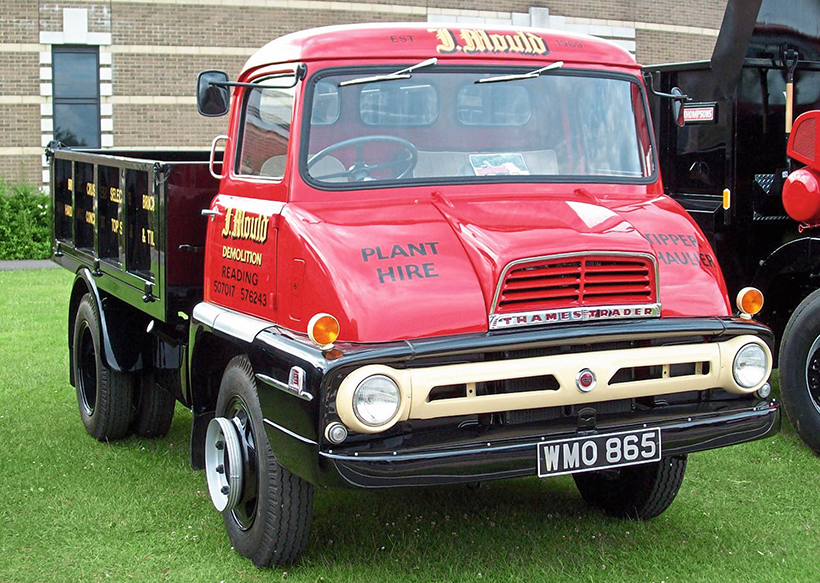
A beautifully restored Mark 1 Ford Thames Trader tipper that was first registered in Berkshire, towards the end of 1960. It appears to be wearing the smaller, 8.25 by 20 tyres.
Before the introduction of the Thames Trader, Ford’s load-carrier range ended with the ‘Costcutter’, which was only specified as a five-tonner. Although the Sussex six-wheeler had been around for a few years, it didn’t really compete head-on with the other mass-produced British vehicles. Ford was entering the four-wheeler big league!
It seems a strange world looking back, when you realise that manufacturers’ designated design maximum gross weights were taken by many hauliers as a guide only, and completely ignored by other operators. Of course, any such overloading of a makers’ vehicles would automatically void the guarantee the manufacturer had originally offered with the sale. That said, a hard-pressed haulier that was working on low rates – which many were – was much more interested in carrying that extra ton or two, and making his next HP payment on time.
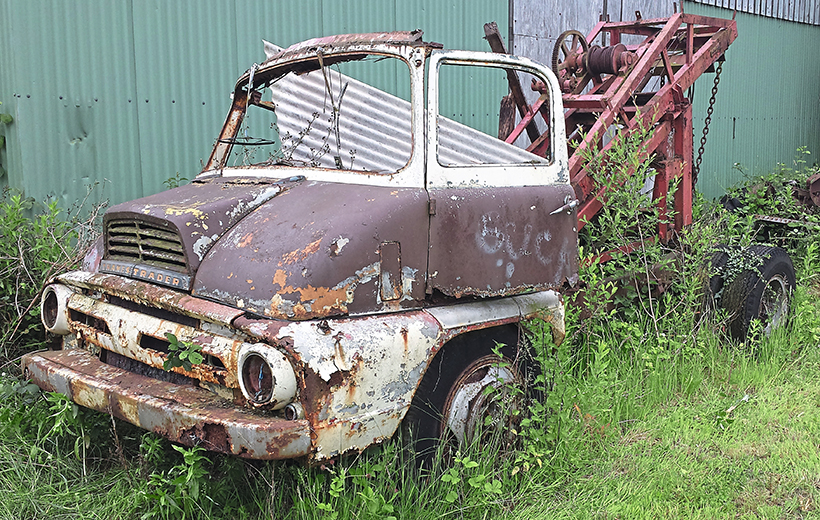
This poor old girl was seen out to grass three or four years ago in an ex-haulier’s yard at Wem, in Shropshire. Apparently, the cab roof had been cut off deliberately: I’ve no idea why.
A good owner-driver would nurse his motor at all times, of course, even though he asked more of his mount than he should. Potholes would be avoided like the plague and, if he should inadvertently hit one, he’d feel the pain of the chassis and springs as if he was being kicked personally. Later, with clenched teeth, he’d look for damage, inspecting the spring leaves and chassis rails closely. He’d let his motor climb the hills, easing his right foot just that little bit, and not rushing to get into the next highest gear; better let the old girl have it easy, not pushing her on, and get to the top without that temperature gauge heading north. Head out of the driver’s window, listening for knocks, or clicks which would mean a tooth in the gearbox had parted company with its gearwheel or worse, easing off a bit if she was struggling and ‘blacking’ until the exhaust was a bit clearer. Really it was a partnership. The owner-driver depended on his steed for his living; be mechanically cruel and he’d pay the price and, with a Trader – or any other seven-tonner of the period – those facts applied.
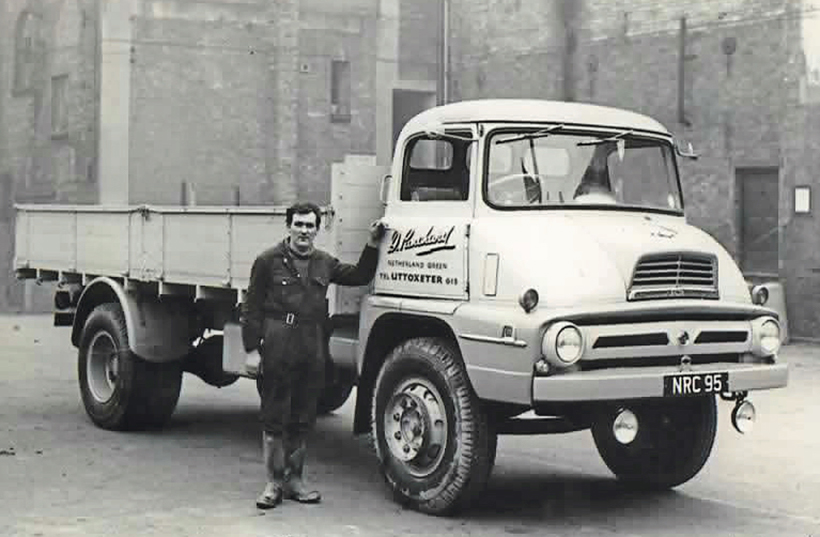
NRC 95 was registered during late 1958, and this picture was taken at the Old Maltings Yard, in Uttoxeter, when she was almost new. I was in the passenger seat – my little head is just visible over the centre instrument binnacle.
Such was the world I experienced as a kid. Look after your ‘tackle’ was the best advice. As far as paid drivers were concerned then, as now, there are excellent, good, and bad. You never wanted to be employing a ‘tear-arse’ really although, on the other hand, you wanted him to do as much work as possible in the day. It was a sort of a Yin and Yang situation.
Some drivers have a very skilled knack of getting the best out of a motor without doing damage at the same time! As far as the law of the land went in the late 1950s, any two-axle goods vehicle could be loaded up to 14 tons gross weight. Prior to June 1956, the limit had been 12 tons gross weight but, by amendment, the government of the day decided that a two-ton increase was an acceptable step forward and, in so doing, also increasing maximum individual axle weights from four and eight tons to five and nine tons.

This is how it was back then! 7/7.5 Ton Traders regularly pulled 14-ton gross weights. GRF 483B sets off again with 9ton! 5cwt (Approx 9.90 tonnes) Payload.
Ford’s design weight for the Trader initially was just under 11 tons gross vehicle weight, so if a Ford Trader was run at the legal maximum which it could carry in the eyes of the law, it was running up the road with an overload of approximately 28%. Such ‘overloading’ was extremely common practice, especially in tipper circles with all makes of four-wheeler at the time. This state of affairs continued right up until testing and plating became a thing in 1969 or thereabouts.
Bigger boots in the way of 9.00 by 20 tyres, perhaps beefier rear helper springs and you were good to go. Dad ran two in the early 1960s, and both regularly carried around 10 tons payload. Seeing as the average seven-ton Ford Trader fitted with tipping body and gear was around four tons or perhaps a little over unladen, the gross vehicle weight then was close to the legal limit of 14 tons.
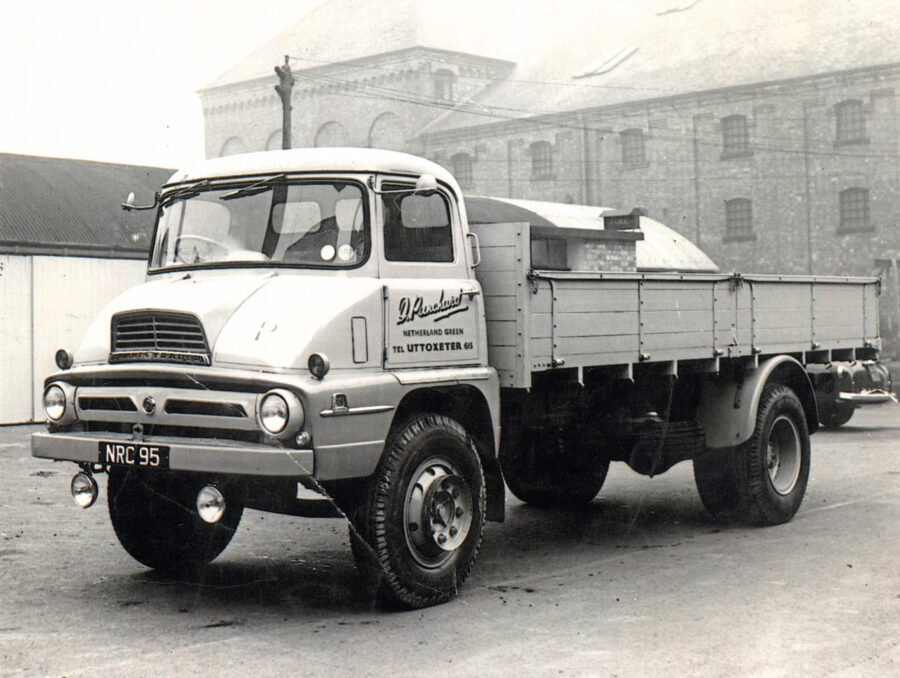
Kerbside view of NRC 95 in Uttoxeter.
My first encounter with Ford Traders was when dad had one brand new around the end of 1958, when he was driving for his very good friend and employer, Doug Punchard. This was NRC 95 and, if you squint a little at the photograph here, you’ll see the top of my head visible in the passenger seat through the windscreen, by the tax disc. Dad was 28 then, and literally there wasn’t enough hours in the day for him to work. It was incredibly rare for him to get home before 9pm (mum’s memory, not mine).
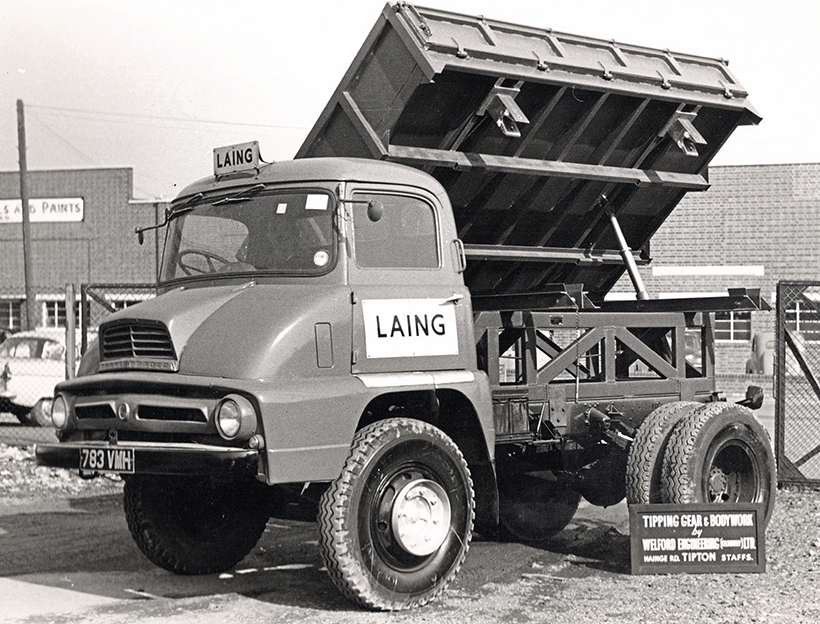
A promotional photograph, perhaps taken by Welford Engineering, of a three-way high-lift tipping Ford Trader. Clearly, Laing Construction was going to be taking delivery of this 1959-registered Mark 1 model. (Image: Courtesy Welford Engineering).
Apart from the photo, I don’t really have a memory of NRC, however, dad’s next new Trader I recall still with the terror I felt when he plonked me on the (polished) bonnet of PCH 998, and stepped back to take the photo included here, he stepped way back and I could feel my bottom slipping! He stepped so far back I knew for sure that should friction ease just a little bit, I was floor-bound and, for a little tot of four, that Trader bonnet was akin to a four-storey building! You think a Ford Trader isn’t a big lorry? Well, think again. Look at it through the eyes of a four-year-old. To this day I’m not good with heights.
Dad started ‘on his own’ in 1960 and, a couple of years later, he bought a Ford Trader of his own, as a second motor and engaging a driver for the other, perhaps better condition, Bedford TK. This Trader, too, I don’t have much recall of, apart from at best it was a stop-gap motor, and a bit rough around the edges. Dad wouldn’t take me with him in this Trader, saying I was better off at home as the brakes weren’t very good. So they must have been awful because the braking system was the Achilles heel of the heavier and earlier Traders; later Mark 2 versions being somewhat easier to stop, especially with modifications.

This photograph was taken from a Ford promotional set of negatives, so I have little information. Is AJ Brush Ltd of Maldon still in business? Someone reading this may know. Doesn’t Trader Mark 1, 953 XVW (Essex, 1961-registered) look well? It’s highly likely that this would have been either a County or AWD double-drive conversion.
The Mark 2 had wider rear brake linings too, increased from 4.25in to 5in. Commercial Motor magazine carried out a road test on a Mark 2 Trader/York artic combination in August 1962, and was distinctly unimpressed with the brakes on offer. According to the tester, the single-axle York trailer seemed to be doing its braking job well, but was let down by the unit. This test was conducted at a gross combination weight of 15tons 3cwt (15.40 tonnes) but, of course, with three axles and three axle sets of brakes. Thousands of two-axle 7 or 7.5ton Ford Traders at that time plied the country’s highways regularly grossing 14 tons. Simple maths will confirm just how stressed those Trader’s brakes would be.
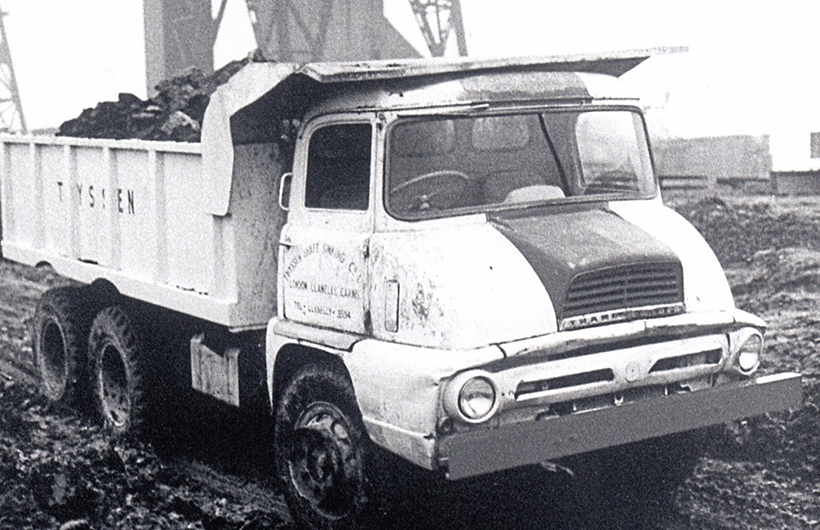
From a Ford promotional film, it appears that this Mark 1 Ford Trader six-wheeler isn’t having the easiest of times. Can anyone identify the location and who the firm Thyssen is or were?
The last lorry I can recall running away and burying itself in a house down the once notorious Cromford Hill, near Matlock in Derbyshire’s quarrying district, was a Ford Trader. Today’s lorry drivers probably don’t even give the hill a second thought, although I believe even recently there have been occurrences where lorries have had accidents coming down it, and calls for the hill to be weight limit-restricted have appeared in the local press. I can only imagine the sheer terror the driver must have felt when he was pressing that middle pedal with all his might, on the steepest part of the 1-in-8 hill, and his Trader was getting away from him. What to do? Jump out? Never the easiest thing to do in a Ford Trader, and perhaps be steam-rolled by the rear tyres. Or try to steer her down? Given where she got away, perhaps a hopeless choice to make. The classic no-win situation.
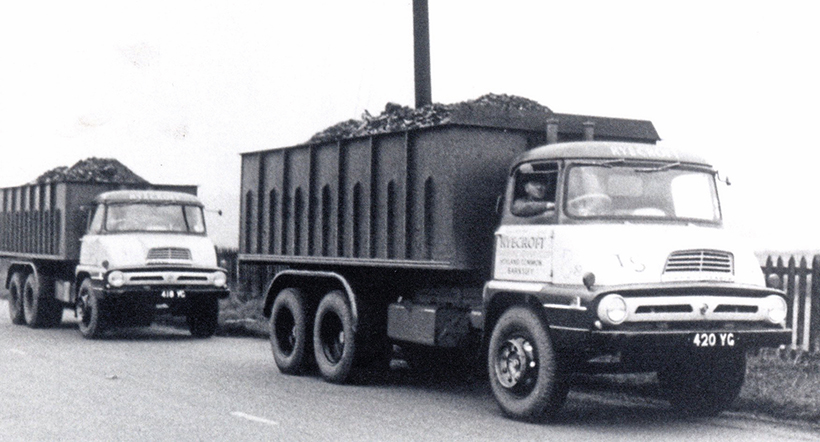
Another Ford promotional photograph of two Mark 1 Trader ‘coalers’. These 1961, West Riding-registered six-wheelers look the bees knees, and I bet they were carrying more than the Ford-approved 10 tons here.
Anyway, the Trader ended up parked in someone’s living room, not bothering to knock on the front door. Alas the details any injuries – or worse – sustained have been lost in the mists of time but, for many years, the repaired front of the house and new stone work were very visible. Today, there’s a crash barrier running down the side of the road where this runaway occurred. Would it have stopped a badly-behaved, fully-loaded Trader? Who knows? It seems good advice on that particular descent, even in this modern world of retarders and disc brakes to ‘Tek care, right there’ tomorrow, today, as most drivers of yesterday did. It was, of course, a well-known fact that most experienced lorry drivers of the time knew when driving a Ford Trader, it was wise to ‘take your time’ down the hills.
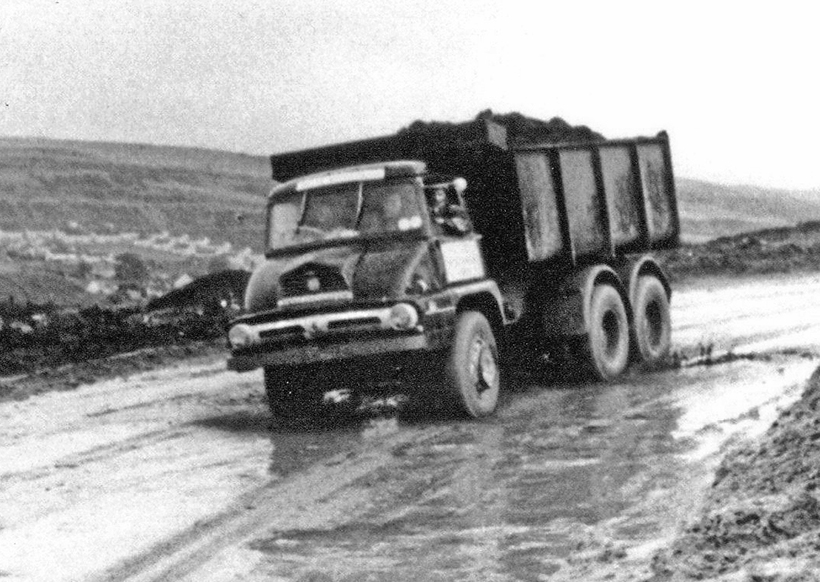
This Ford promotional photograph shows a lovely six-wheel Trader Mark 1 having a hard time. Can you imagine those springs working, the chassis flexing and creaking as the Ford chassis rivets are put under stress? It’s obviously carrying a big load for a motor originally designed to haul seven tons.
Component manufacturers also latched on to possible sales opportunities, one of which – Westinghouse – was offering air-brake conversion kits for the Trader by 1962. In essence, the brakes were operated by an air-over-oil system, replacing the vacuum-over-oil system which was standard fitment, as far as I understand it. I believe Ford actually offered the air-over-oil option as original equipment towards the end of Trader manufacture as well.
When I see a restored and rallied Ford Trader these days I still find it hard to believe that they were regularly loaded with a 10-ton payload. Look for a moment at the size of the spring hangers and shackle pins on the Trader, then perhaps go and have a look at the same components on a four-wheel ERF or perhaps an Atkinson. Even at 16-ton gross, these heavy weight motors didn’t carry much more!
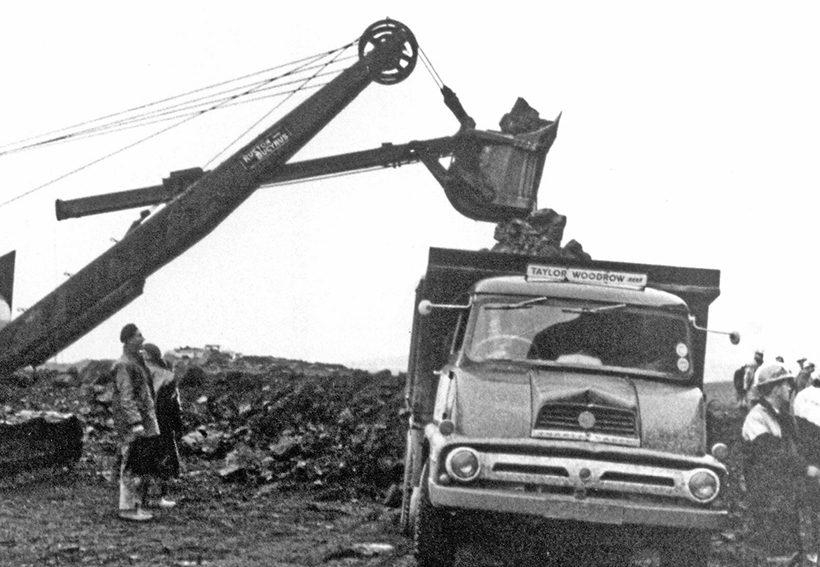
This Ford promotional photograph shows a Taylor Woodrow six-wheel Trader that’s had a bump on the nose! Here we see tipper haulage at its hardest, loading clay and soil via a ‘Navvy’ loading machine, and then the sticky goo has to be tipped off, perhaps encouraged by several shunts to exit the lorry body. It would all make a new Trader very old, very quickly.
In this article I refer to the larger Trader models, because those are the ones I remember in particular from my childhood. Most seven-ton tippers of that period – whoever manufactured them – were loaded to 14-tons gross weight, as already mentioned. But perhaps the Trader brakes were the least capable of dealing with what was a very large overload. Certainly the early Traders ran the exact front foundation brakes made by Girling, with just half-inch wider linings than are fitted to a Thornycroft Swiftsure, which rated its four-wheeler for only a six-ton load.
So far I haven’t ‘praised’ the Trader very much have I? Well, I ask, isn’t there something very special about knowing most of the faults that a vehicle has (or, for that matter, a person!) and, despite all, still loving them dearly? I do love the Ford Trader dearly; I only have to see one and my goosebumps appear, and I get all misty-eyed, never mind about the 6D, with its wet liners (which I’m not crazy about). Or how you almost sit on the cab floor when at last you reach your seat after balancing precariously on the step ring (a big stretch especially when I had such little legs).
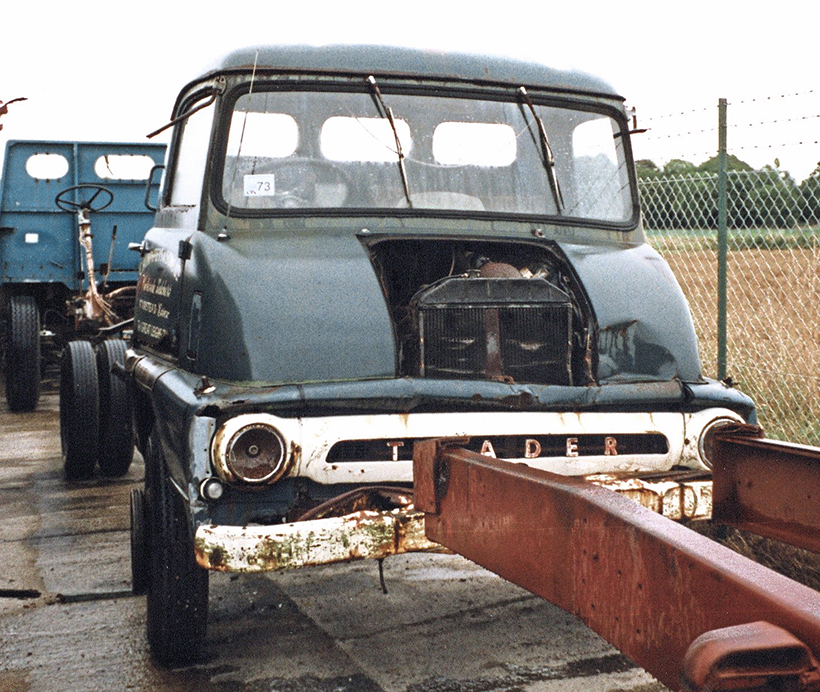
Taken at a Kevin Dennis Sale in Lincolnshire quite a few years ago now. I wonder whether this Mark 2 Trader made it into preservation. It would be nice to know as she looks complete and just ripe for restoration. The Mark 2 Trader had a mechanically-governed fuel pump, instead of the earlier vacuum-type governor.
It is a beautiful lorry, quite unlike anything else ever produced in this country. I love, in particular, how Ford shoehorned a dual passenger seat as an option, leaving the person in the middle between driver and passenger to cantilever their legs around the strange-shaped bonnet. In fact, a bonnet shaped in such a way that it completely excluded the possibility of covering it with any kind of rug or blanket to deaden the 6D’s roar.
I loved, as a kid, seeing the gear change pattern drawn out, with ‘O/D’ instead of ‘fifth’, inciting thoughts of fast progress along empty roads. Fifty miles and hour was no problem when the driver was in O/D. Never mind that he couldn’t stop! An option of the two-speed axle was the icing on the cake; just a quick dab of the clutch and low axle was engaged… magic… fantastic.
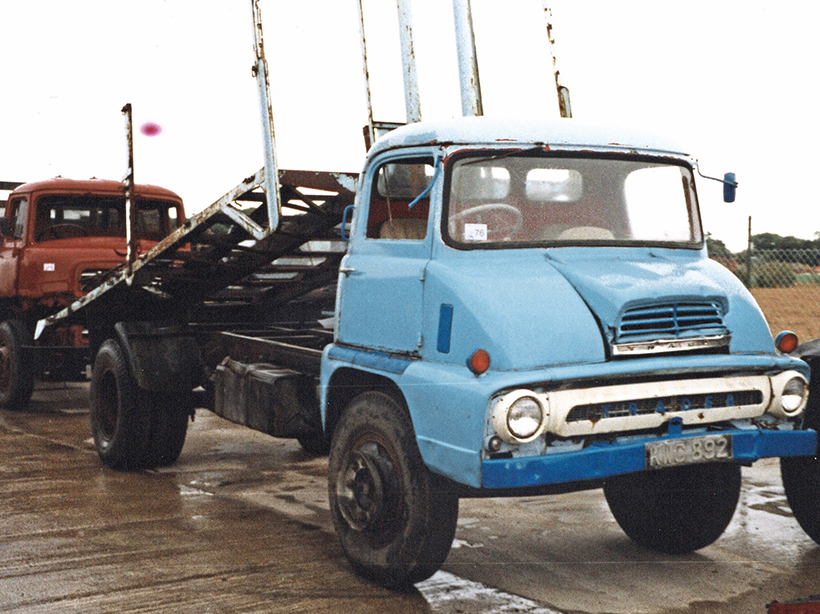
Another Mark 2 Trader at the same Kevin Dennis Sale. This one a beautifully-proportioned, three-quarter wheelbase tipper. I wonder, did she win someone’s heart on the day? KWC 892 was registered in the autumn of 1963.
So my dad’s last Ford Trader was little more than six months old when he bought it off a guy who’d got into financial difficulties with the repayments after having it brand new. Dad was contracting for one part of a big London-based firm, this chap was working out of a different quarry owned by the same holding company. I was with dad the day he got talking with the original owner. It did look well, a three-quarter wheelbase, not one of the very short ones, and it sat so well, too. Lorry men will know what I mean by that.
Dad said to me: “Go on Alan, have a sit in it.” He didn’t have to ask me twice. Overdrive ‘box, two-speed axle, I remember the protective paper was still covering the little sun visor. Dad leaned against the wheel and said to me (I was nine years old then), “What do you think?” My reply was: “Are you going to buy it, dad?” Thoughtfully he said, “I just might.” I remember that as if it was yesterday not 50-odd years ago. I was so excited!
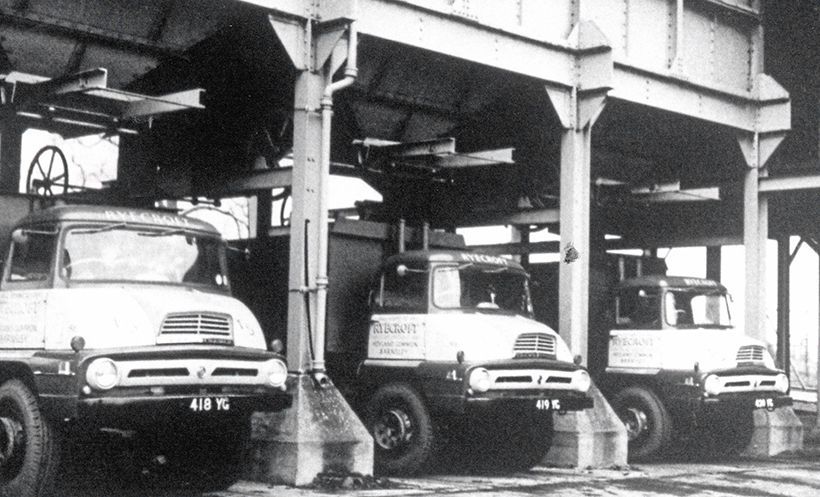
Ford promotional photograph illustrating a time when coal was king, as six-wheel Traders load under the bins.
So the final Trader that I was to have close contact with came home! Registered GRF 483B, it was a ‘Trader 75’ Mark 2 and, sadly, I have no photograph of it. But I remember it as a lovely lorry; blue and red in colour – blue cab, red wings and chassis. Dad had bought a brand new Commer six-wheel (Primrose third axle) ‘Stroker’ earlier in 1964 and he was driving that, but there was a driver for the ‘new’ Trader he had in mind. From my saved records, both man and machine worked extremely hard.

Here we see the other Thames Trader, the Normal Control or NC very often referred to as the ‘German Thames Trader’. This design of cab was first introduced by Ford in Germany in 1955. However, by 1962 when introduced in Britain, the model had been dropped from the Ford Cologne production programme. Perhaps the cab was still made at Germany’s Ford Plant, but according to Commercial Motor, the NC was made in Dagenham. I always thought they were produced in Germany in their entirety, myself. I know little about this model, which I believe went on to be called the Ford K Series. I only knew of one owner driver who operated one (a seven-tonner). They were actually quite rare in our circles. This looks to be quite a late one on a ‘D’ plate registered in 1966.
On October 8th, 1964, dad’s driver – Ken – loaded at Wirksworth Quarries (Derbyshire) nine tons 2cwt of Tarmac for delivery to Brookmans Park, in Hertfordshire, which isn’t too far from South Mimms. He went over the weighbridge in the quarry at 4.15am loaded and, by 1.45pm the same day, he and the Trader had arrived back at Wirksworth. Then the Trader was loaded again with Tarmac and weighed on the weighbridge at 9 tons 15cwts, before departing for Mansfield, Notts. You know I feel that even with today’s powerful modern engines and automatic gearboxes and brakes that will stop a vehicle on a ‘sixpence’, that would still be an awfully big day’s work, bearing in mind that he had to return from Mansfield to park up.
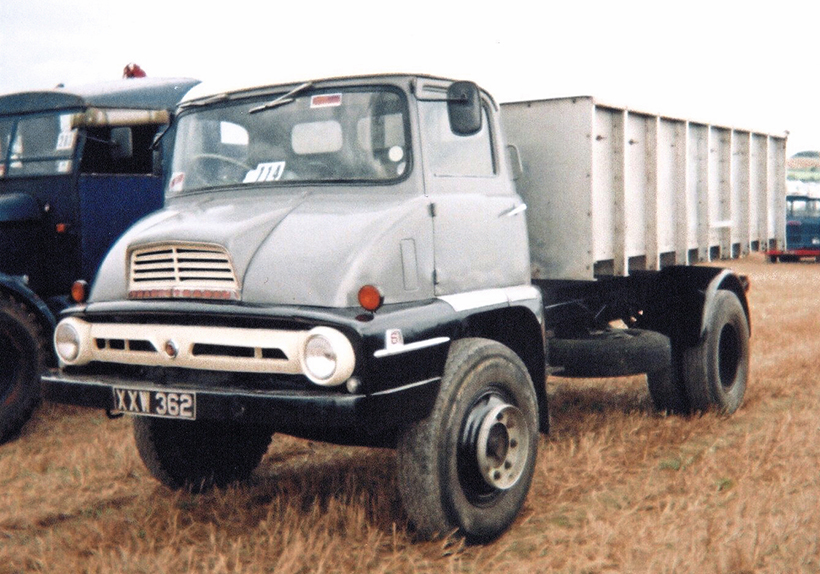
Lovely three-quarter wheelbase Mark 1 Tipper. Taken, I think, at the Great Dorset Steam Fair a few years ago. Registered in 1959/60, this beautifully-proportioned Trader looks just as it should. To me it looks just like an owner driver’s motor from back in the day… superb!
Of course the roads were much quieter then, and the logbook system meant that driver’s hours could be, well shall we say ‘creative’. But, even so, the 100 or so bhp Trader with around 7bhp per ton, definitely did it all that day. Dad ran the Trader for around 18 months and, by that time she was starting to get a little tired, big loads and high speeds were taking their toll, the old (or perhaps not so old) girl was being asked to go above and beyond what she’d been designed for, every single day.
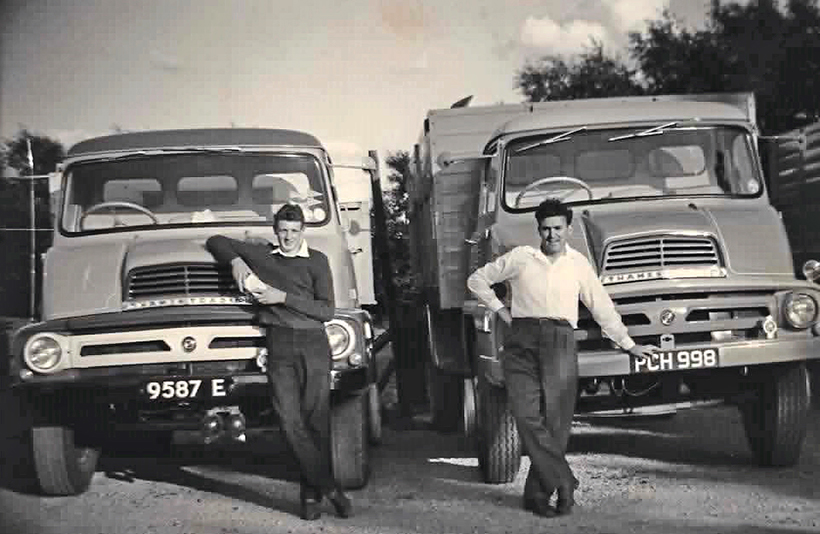
‘Little’ Doug (the owner’s son) stands proudly by his mount 9587 E and dad stands by ‘his’ brand new Ford Trader PCH 998 which his friend and employer Doug Punchard, had just purchased from Kays of Derby for him to drive, hence the Derby 1959 registration. Note ‘Little’ Doug’s Trader wasn’t fitted with indicators (or flashers as they were known back then) ‘Little’ Doug told me recently that when this picture was taken he was under 21, and serious measures had to be undertaken to get 9587 E below the three ton unladen weight mark so that he could then pilot it, legally.
I suppose this was where the proper heavyweight motors showed their metal, the AECs and Leylands, ERFs and Fodens the motors that the average tipper owner-driver could never have afforded to buy initially, but would keep performing for much longer than the abused average seven-tonner of the day. GRF was sold when just over two years old, and I never saw her again. It doesn’t seem very old today, looking back, to be moving a vehicle on. However, friend of our family and known just about all over the country as a vehicle dealer and scrap merchant at the time, Jim Marsh, told me many times how, in the early 1960s, he was regularly breaking seven-ton Traders at 18 months old. Tipper hauliers back then asked an awful lot of the humble Trader, however, some were ear-marked from building for even heavier service. I speak here of the Traders that were converted into six-wheelers, some were made into twin-steers (or ‘Chinese sixes’… a term I hate), but the vast majority were re-constructed as normal six-wheelers – most with propriety trailing axles, from the likes of the Boyes, Primrose or York companies.

A baby Trader with six-stud wheels and a nice dropside body. Taken a while ago – I forget where – perhaps it’s a three- or four-tonner?
Ford supported conversions from County, and perhaps AWD, too, but only for a maximum gross weight of some 16 tons. In reality, many would have almost carried 15-ton payload, and been within the 20-ton gross six-wheeler legal limit. I believe many County and AWD conversions – if not all – were to a double-drive system, however, the only personal knowledge that I have of six-wheel Ford Traders were of the flats that Taylors (corn millers) of South Wingfield operated. I remember watching them shunt about and load at the mill, (when bunking-off from school just up the road!); they just looked fabulous with their bright red paint. As I say, these were proper big motors back in the day. Incidentally, Taylors Corn Mill still operates today, sadly the Traders have long gone, but they made an impression on at least one little boy!
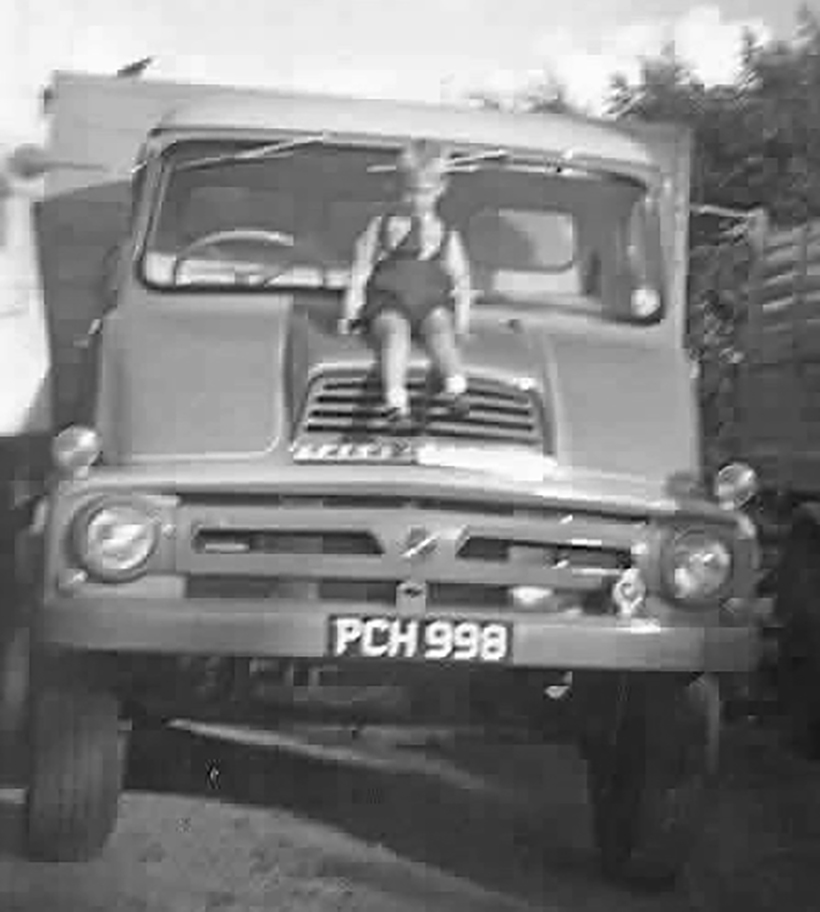
If ever there was a case for more traction control, it was at this moment in my early years. For those of you that don’t realise, those Trader ‘snouts’ are bloody steeply angled! It’s a long way down, too, when you haven’t even started school yet.
Commercial Motor tested a Ford County six-wheeler back in June 1963 and, again, the brakes came in for criticism. It was explained that the third axle had its own smaller Hydrovac. However, running at 16-ton gross under heavy braking, both rear axles locked excessively, lengthening the stopping distance and, with axle hop too. So perhaps the front brakes weren’t doing their fair share of the work. The testers also concluded that the handbrake was only just good enough. I’m sure another four tons of payload – which many six-wheel Traders would have been asked to carry – would have softened the rear brake locking issue! Commercial Motor was adamant that the Trader wasn’t a suitable vehicle for 20-ton gross weight in several places of the road test report but, for many hauliers, that extra four tons represented pound notes. Need I say more?

From a Mark 1 Ford Trader brochure. Pictured is a short-wheelbase Trader tipper. There must have been thousands like this one on the roads of Britain back in the day. But check out the happy driver, white overalls, cap, collar and tie; clearly he was living his best life!
There was no third diff fitted to the Ford Trader/County so, much like many Fodens of the time, all rear tyres would have to be matched. If you put good tyres on the first drive, then good tyres would have to be fitted to the third axle, too. If not, serious differential wind-up would occur. Traders were also converted to four-wheel-drive for off-road and bad ground use, where they were used among other things as lime-spreaders.
In conclusion, when Ford announced the Thames Trader range back in 1957, it introduced a winner. Cheap and cheerful it might be said, but browse the back section of any Commercial Motor from the early to mid-1960s, and the sheer number of Traders listed for sale is staggering, I would go as far as to say you would find as many Traders for sale as there are Bedfords. The only caveat to that would be in the coach world where the Trader never seemed to be as numerous as the Bedford.
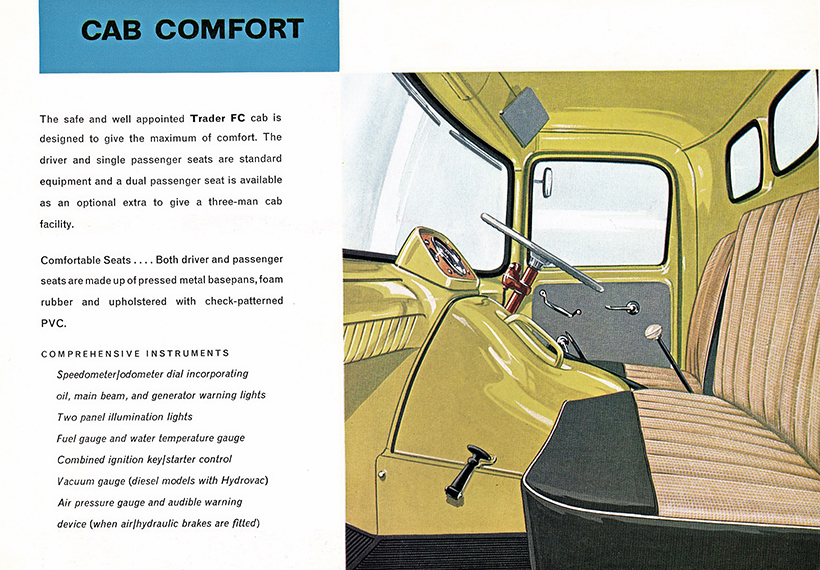
The Ford Trader driver’s ‘office’… Ford brochure showing the inside of the Trader cab. The double passenger seat was a bit of a shoe-horn arrangement, from what I recall. Note the tiny sun visor, and lack of two-speed axle button on the gear lever – shame. The shape of the bonnet meant it was very difficult to drape the usual sound-proofing blanket or bit of carpet over, without it continually slipping off.
Of course the initial pricing of both the Bedford and the Trader meant that they were a highly attractive proposition to many haulage contractors, especially the owner-drivers of the day, at a time when Hire Purchase (known at the time by many as ‘The Drip’) wasn’t always easily obtained. A little mining of my old Earls Court Show Guide for 1958 reveals the following; A Maudslay (AEC really) Mercury chassis cab would cost £2,008 (£60,022 in today’s money). An ERF 44G Chassis Cab would cost the haulier £2,268 (£67,794 today). However, a seven-ton Ford Trader 6D bodied-up as a tipper, in primer and ready to go, is listed at £1,420 (£42,446 today)! Bedford got close to that price with its diesel ‘S’ Type at just another £20 dearer bodied as a tipper. But, if your head had been turned by a Commer Stroker (TS3) then, for just a chassis cab with standard platform body, you would be writing a cheque for some £1,565 (£46,780 in 2023).
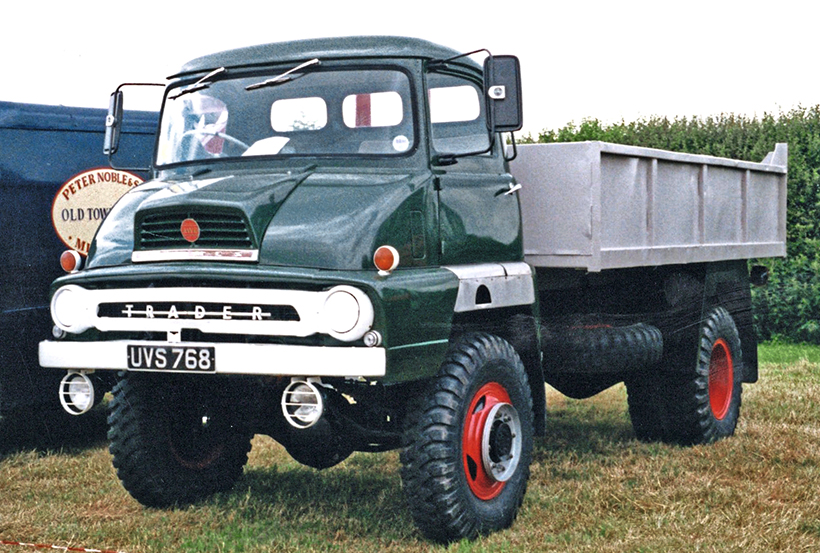
This is a Mark 2 Trader tipper which has been converted to four-wheel drive, she looks a big motor, especially being a little higher off the ground, with off-road grippy tyres. Three quarter wheelbase too. I think this Trader would have started life when manufactured as a 7 or 7.5 ton chassis. Note the headlights have had to be lowered to conform with construction and use regulations, and an extra foothold has had to be added at the bottom of the door to help those of us with shorter legs make the climb from step ring to seat. It’s almost certain that this motor would have had to contend with really challenging off-road conditions during her working life on a regular basis, making it even more remarkable that she has survived into preservation, and looking so well too.
But that wasn’t quite the end of it as the dreaded Purchase Tax added nearly another quarter again to the manufacturers price. Taking all that into account, and the fact that the Trader was, by and large, a really good motor, it’s little wonder that as well as seeing Bedfords everywhere, Ford’s Trader were around every corner, too!
This feature comes from the latest issue of Heritage Commercials, and you can get a mkney-saving subscription to this magazine simply by clicking HERE

Previous Post
A beautifully restored, 1973 Bedford TK horsebox
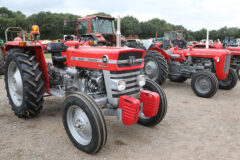
Next Post
We report on Cheffins’ impressive mid-summer sale



